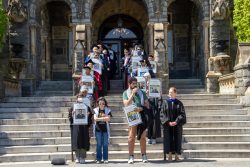According to enrollment statistics released by the Office of the Registrar on Sept. 27, African American students currently comprise 2.57 percent of the 2,486 students in the Graduate School of Arts and Sciences, while Latinos make up 8.89 percent.
These numbers are only released to University officials and other members of the University community upon request, according to Vice President of Institutional Diversity and Equity Rosemary Kilkenny. Like Georgetown, other private universities do not typically publish minority enrollment statistics, making it difficult to compare Georgetown to other institutions.
Other graduate programs at Georgetown University show similar enrollment numbers. African Americans comprise 5.5 percent of students in the combined doctorate in law and masters of law programs, 5.7 percent of medical students in the Graduate School, and 6 percent of those pursuing MDs in the School of Medicine.
Latino students represent 5.7 percent of students at the Law Center, 4.7 percent of medical students in the Graduate School, and 3.18 percent of students in the School of Medicine. However, 46 percent of law students did not report race or ethnicity in their applications.
It is possible that these numbers may be similar to the diversity of the applicant pool to Georgetown graduate programs. But, it is impossible to know for sure as Eric Smulson (C ‘89), vice president for public affairs and senior advisor to the president, did not authorize the release of applicant pool statistics.
Maurice Jackson, professor of history and African American studies at Georgetown, believes the numbers are not “spellbinding” but are generally in the norm with other schools.
“I think that like all other universities, our numbers should definitely be higher,” said Sheila McMullan, associate dean for administration and finance at the Graduate School of Arts and Sciences.
McMullan said that student debt is a strong contributor to the low numbers of minority students in particular because it disproportionately affects minorities and deters them from taking on the costs of further education. According to a 2012 report entitled “The Student Debt” from the Center for American Progress, 81 percent of African American students and 67 percent of Latino students who attained bachelor’s degrees were in debt upon graduation, in comparison with 64 percent of white students.
According to the report, “27 percent of black bachelor’s degree recipients had more than $30,500 in debt compared to 16 percent for their white counterparts.”
“If people have already amassed debt from their undergraduate education … at some point people are really scratching their heads and saying, ‘wait a minute, do I want to go to law school and incur a hundred thousand, two hundred thousand more in debt, with no promise of a job that will enable me to pay off those loans between five to 10 years?’” Kilkenny said.
The need-based financial support currently given to 38.7 percent of undergraduates is not applicable to graduate students, whose financial support is solely merit-based.
“We give out about, in scholarship support from the graduate school, maybe $10 million, and it’s just not enough,” McMullan said.
“The problem is, we are the nation’s capital, we have to do a bit better. One problem is the very rich schools, Brown, Harvard, Yale, Princeton, Stanford, they offer much more money [for financial aid],” Jackson said.
Low high school graduation rates among Hispanics and African Americans significantly reduce minority representation at the undergraduate level, leading to a smaller minority applicant pool at the graduate level, especially for PhD programs, only offered in Georgetown at the Graduate School of Arts and Sciences.
“The higher you go, the smaller the numbers get,” Kilkenny said.
As PhDs prepare students to teach at Georgetown and other educational institutions, diversity in enrollment is integral to creating a diverse faculty.
“You want that pool to be as diverse as the classroom. You want to make sure your professor is as diverse as the nation,” McMullan said.
However, low minority numbers are likely to persist without financial support.
“I understand there are some measures to go in and get more African American students, but nothing’s going to do more, unless we raise money,” Jackson said.




